
CASIO |
phase distortion FM keyboard with 100 sounds & drum computer |
This keyboard from 1986 was the smallest model of the famous Casio CZ- series synthesizer series and constitutes an odd hybrid of the Casio CZ-101 sound engine, the Casio RZ-1 drum computer and anticipated the idea of a 100 sound ToneBank home keyboard. Like home keyboards it has a (fairly oversized) internal speaker.
But before you think this must be an exciting combination, regard that despite the sound generator employs the same phase distortion (PD) synthesis engine like Casio CZ-101, unlike the latter there is not even the simplest parameter editor built into this instrument, thus you can only edit the sounds through an external computer using MIDI sysex commands, those overwrite the preset sounds 96 to 99. (By my knowledge there is no free PC software available for this task, but only commercial CZ editors.) And despite there is a complex rhythm section with even a real programmable drum sequencer, there is no automatic accompaniment and not even a key split mode to play manual accompaniment (without external computer) despite the sound generator is multi- timbral through MIDI. The PD sound source employs 2 "lines", which corresponds to 4 operator FM, but with more complex envelopes and noise generators in comparison to ordinary FM keyboards. This way it can simulate certain analogue timbres and drums better than normal FM keyboards. It can do e.g. nicely warm bass and bizarre synth pad textures, but also picked strings, metallic sounds, strange percussion and synth piano stuff.
The built-in drum computer has 20 semi- OBS preset rhythms and 10 programmable user patterns, but no intuitive realtime programming. The percussion is made from fairly dull medium resolution samples those knock not bad but have a strange woody timbre that reminds rather to home organ percussion than to a genuine drum kit. Special are typical woodblock and Arabian sounding drums; also some preset rhythms sound nicely oriental. Up to 4 additional percussion sounds can be programmed using the PD synthesizer (haven't tried yet).
Several CZ-series keyboards including CZ-230S have been emulated on MAME.
Casio's phase distortion (PD) was basically a more advanced competitor to Yamaha's well known FM synthesis. Since about both is much info available on the internet, I won't explain the technical backgrounds here. The biggest technical difference between both is that Casio added for the parameters a way more versatile 8 step envelope with higher resolution (any step can be defined as sustain phase) and a better noise generator. Do you still remember the old DOS games for PCs with Adlib soundcard, where all shots and explosions could only sound either pale and hissy like unscrewing a bike tube valve, or sounded like "blaoom!" or like a mixture of both? Then you know what crappy unflexible noise generator Yamaha had built into their old FM soundchips. Casio instead added a way more sophisticated noise generator (US patent 4656428) that can produce a lot of differently coloured noise timbres by modulating the pitch of a tonal sound with random numbers, which e.g. can sound like sending white noise through analogue filters with filter envelope. This way the CZ synths can do e.g. realistic snare and other percussion noises far beyond the infamous thin sounding "bub!", "ts!", "ding!" or "djiff!" of old FM soundcards.
For phase distortion Casio also invented a different (more logical?) terminology modelled after analogue synthesizers, while Yamaha with FM stubbornly called everything very mathematically "modulation" of "operators" - independently from what they actually do with the sound. (Casio instead e.g. calls a 2 operator pair a "line", and when 4 operators are connected as a chain, then 2 lines "ring modulate" each other. For details download the Casio CZ-101 manual.) I read somewhere that the main reason for this strange terminology was that Yamaha had patented the principle behind FM synthesis, which relies on the multiplication of basic waveforms to generate more complex ones. Thus Casio attempted to enshroud the inner working of their PD by explaining the same physical phenomenon from a different view using the mathematical derivation of Yamaha's at that time patented FM formulas, despite both electrically do the same or at least very similar things. Other rumours claim that Casio's PD hardware employs more general lookup- tables mappings instead of mathematically exact multiplications to circumvent the patent, which only results in slightly different timbres (or even in the same when as a special case the employed table "coincidentally" maps a multiplication).
But most important is how it sounds. By ear I noticed that my Casio CZ-230S can sound less resonant and hollow than my FM instruments based on Yamaha sound chips; i.e. in a timbre sweep where FM goes "baaohñññg!", PD instead can also go "bauuung!". The difference can be likely compared with different filter characteristics on analogue synthesizers. But possibly this is only caused by the finer envelope control and higher parameter resolution on the PD sound generator. PD can also do synth pianos those sound like made from analogue filtered squarewave. Interesting is that these pianos with their buzzy bass range sound more like designed to imitate the piano sounds from Casio's older consonant- vowel synthesis instruments (see e.g. Casiotone 201 and CT-410V) than the for FM typical Rhodes imitations. Normal FM pianos turn rather dull or hollow in the bass range instead of getting buzzy. But PD can also do the normal smooth and resonant timbres I know from my 2 operator FM instruments. Another difference is that with 4 operator "ensemble" sounds (those halve polyphony) on Yamaha FM there is an audible rastered texture in the timbre, while PD timbres stay perfectly smooth (which sounds cleaner but IMO also boring). But both technologies can sound warm (with my Fujitone 6A even more than my genuine Yamaha FM keyboards) and also both can produce nasal detuned chorus timbres (e.g. "sitar" on Yamaha PSS-390), thus this is no specific property of PD synthesis, although with strongly distorted sounds my FM keyboards tend to have harsher trebles.
In a nutshell it can be said that PD is FM with some reasonable additions, and yes it sounds nice.
Related US patents are e.g. 4658691 (general), 5038661 (simplified waveform generator), 5040448 (user programmable synth). Because the Casio CZ-230S is well documented on the internet, I won't explain its operation in detail here, but mainly describe the sound.
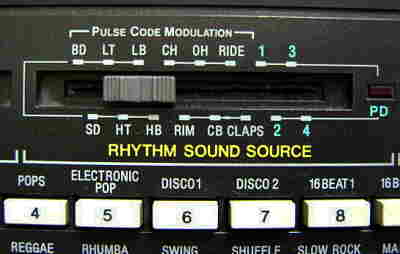 |
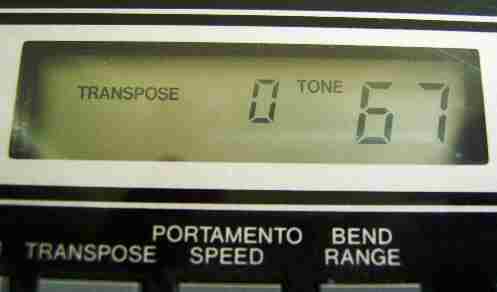 |
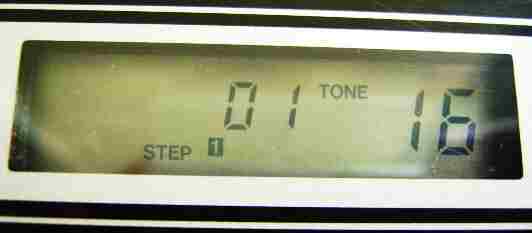 Unlike other CZ synths, the CZ-230S has no dot matrix LCD.
Unlike other CZ synths, the CZ-230S has no dot matrix LCD. |
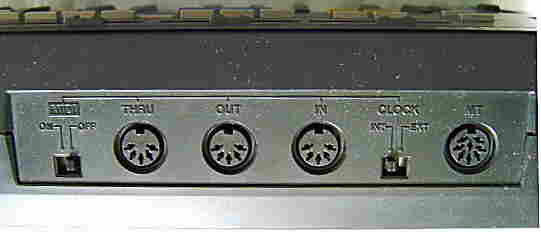 |
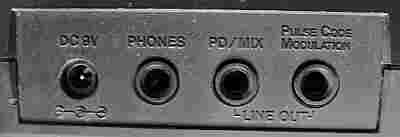 |
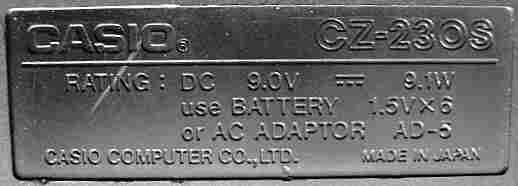 |
polarity protection diode added, power supply jack polarity corrected.
Attention: When the Casio CZ-230S is disconnected from power for some days with no batteries inserted, it looses its RAM contents and by this often crashes so deeply that all preset sounds or at least the sounds 96 to 99 stay mute. Sometimes it even turns itself off when starting a rhythm. To fix this, simply reset the instrument (erases memory contents) by holding the red "C" button during power-on.
Although there is a 100 sound bank on the CZ-230S, the sound set differs a lot from normal (later) Casio 100 ToneBank PCM instruments, but like these (see Casio SA-1) it already makes heavily use of sustain, echo and strange modulations after key release. Despite some identical sound names, most are not even similar. Like with normal FM instruments, also here the keyboard is time dynamically playable, i.e. with many sounds the timbre and volume of the release phase varies with the key press duration. Unusual for an FM based instrument is that there are only few of the overused FM Hammond organ and Rhodes piano timbre variants among the presets; likely Casio wanted to clearly demonstrate its independence here.
The "brass ens." sounds are typical fat 4 operator FM synth brass timbres, those have little similarity with accoustic instruments. Also the "symphonic ens." 1..2 are similar timbres, while 3 is a synth horn or thrombone timbre with a dose of chorus, tremolo and short sustain. The 2 "string ens." timbres are fairly realistic; 2 is higher and with some sustain. "synth. ens. 1" is a creaky synth brass with vibrato and sustain, while 2 resembles a metal pipe organ rank with vibrato and sustain; after key release the vibrato turns slower. "light harp" is a glassy synth brass with percussive attack phase and vibrato, which speed increases with the note pitch; the bass range is more like an e-bass. Also "mars sound" is such a synth brass, but less percussive. "southern wing" is a bright and nasal timbre like a short looped sitar sample with sustain. "magical wind" is a creaky, thin organ timbre with vibrato. (It was likely the model for "pop- lead" in the Casio SA series since both sound identical.) "funky horn" is a fat and bassy FM synth brass, which bass range resembles an e-bass. "slap horn" sounds similar, but thinner and layered with a Hammond organ timbre. "sweet strings" is a dull and slightly brassy synth strings timbre with vibrato and some sustain; the bass range resembles a tuba. "light attack" is a nasal brassy organ timbre with percussive attack, fast fluttering 6Hz chorus vibrato and some sustain. "synth. harp" is the classic cheesy FM plastic harp, but here with long sustain; bass range resembles a dull wood drum and high notes porcelain bells. "metallic sound" is a bright, percussive and semi- metallic funky clavinet timbre with dull reverb. "jazz organ 1" is a pseudo- Hammond organ timbre with delayed 6Hz vibrato and horn- like sonorous bass range. 2 is similar but creakier and more distorted (no typical FM). "pipe organ 1" sounds between metal pipe organ rank and Hammond organ with weak fast tremolo and some sustain. 2 is a flute- like high metal pipe organ timbre with quiet sustain; bass range reminds to filtered multipulse squarewave. The "accordion" has a semi- realistic timbre with fluttering fast tremolo and fades a bit quieter and duller. "female chorus" resembles more a soft metal flute or theremin with vibrato than a real voice. "male chorus" is a strangely woody "ah" voice with mild vibrato, than resembles more a horn or vox humana pipe organ rank. "space voice 1" is more a dull synth violin or bowed glass or theremin with slow attack phase and a strange fluttering tremolo; it fades quieter and has some sustain. 2 resembles rather a Hammond organ with remotely voice- like drawbar setting, delayed vibrato and quiet sustain. "wah voice" is a variant of "male chorus", which woody horn timbre rather goes "bah" than "wah" and contains a mild chorus texture and quiet sustain; short note resemble a hen. Although these human voice timbres are everything but realistic, they sound at least less thin than such timbres on early Yamaha FM keyboards or Fujitone 6A. The "trumpet" also goes "bah" during attack and has some vibrato. The "flute" has a delayed vibrato, while "whistle" is higher and fades quieter (more like a theremin). The "violin" has a delayed 6Hz vibrato and sounds halfway realistic. The "cello" otherwise fades brighter and dull again and has a strange phasing texture; it rather resembles a muffled circular saw or high pitched motorbike since it fades way too bright in the middle of its "meow"; the bass range drones nicely sonorous and woody while high notes resemble a mosquito. The "blues harmonica" resembles more an oboe, which howls a bit higher during attack and has delayed vibrato. The "sakuhachi" is synth flute which fades brighter and dull again and has a delayed slow vibrato; the mid and low notes are rather brassy. The "koto" is a realistic sounding bright picked string; "shamisen" is shorter and has a clicking attack phase. "quanun" is another bright picked string that has a small dose of chorus and resembles a sitar. The "synth reed" resembles a cheesy plain squarewave musicbox, while the bass range turns dull in a very FM- typical way. "pearl drop" resembles a steel drum layered with a flute with pitch- depending vibrato and has some sustain. "double reed" resembles a bright saxophone with delayed 6Hz vibrato; the timbre changes slightly with each key press by a phasing effect. "meow attack" is an analogue synth organ timbre with vibrato and a filter resonance envelope; during attack it rapidly turns bright, during sustain dull again (no similarity with cat meow). "soft attack" is a sort of brassy organ timbre with fluttering phasing component. "fantasy 1" is a sort of sine wave organ with percussive attack and a tremolo only during sustain. 2 resembles a flute with slightly percussive attack, pitch depending tremolo and some sustain. "plunk extend" resembles a short e-bass sound followed by a high and louder fading synth flute with pitch depending vibrato and long sustain (very different from Casio SA series). "slash reed" resembles a thin saxophone with a smacking high zap noise during attack. "synth sitar" is a sitar sound that howls a note brighter and lower again with long notes and fades brighter.
"piano 1" fades slightly brighter and duller again and sounds a little brassy, while 2 sounds like a warm analogue piano sound made from filtered squarewave. 3 is similar but thinner. The "honky- tonk piano" has a detuned, slightly cold chorus (resembling My Music Center "piano"). "elec. piano" resembles a Rhodes and is the only typical FM piano. "harpsichord 1" is rather a percussive clavinet; the note stops immediately after key release. 2 behaves normal but is a typical FM timbre that sounds a bit metallic and goes dull in the bass range. "synth. clavi." resembles "harpsichord 1", but distorts during attack like a lead guitar; bass range resembles a funky e-bass. "metal honky- tonk" is a chorus timbre that rather resembles a badly synthesized sitar and goes duller in the bass range. "double attack" is similar but cleaner with longer sustain and has (except with short key presses) 2 fast attack phases, which resembles mandolin ring or a fast echo. "bells" is a typical FM tubular bells sound (slightly disharmonic with very long sustain), while "carillon" is a clean bell sound, which somewhat sounds of ceramic bowls and goes dull in the bass range. The "synth celesta" resembles a glockenspiel but holds the notes with held keys and has slower turning tremolo during sustain. "synth. vib. 1" is a vibraphone with vibrato and long sustain, while 2 is similar but timbre is lower and resembles a vibraphone synthesized from filtered multipulse squarewave (like in Yamaha PS-30). 3 resembles plain squarewave and holds notes with held keys while it fades a bit duller; after key release there is a slower turning tremolo in the sustain phase. "bell- lyra" resembles a glockenspiel and low notes rather ceramic bowls. The "xylophone" sounds fairly realistic, while "soft xylophone" resembles a vibraphone with 6Hz vibrato (bass range like filtered multipulse squarewave), but notes decay very fast after key release. The "marimba" distorts to little to sound credible. With all guitars the note stops immediately after key release. The "aco. guitar 1" timbre sounds fairly ok; 2 sounds thinner and hollow in the bass range. "semiaco. guitar" is similar but with a dull (more realistic?) guitar timbre. "feedback" is a distorted lead guitar sound followed by a feedback tone (sine wave, note stops with key released). "elec. guitar 1" is another distorted e-guitar, while 2 sound like the same as major chord (metal guitar?). "elec. bass 1" sounds dull and warm, 2 sounds brighter. "slap bass" has a hollower timbre with buzzing attack. "metallic bass" has a heavy metal distortion and delayed slow vibrato.
"synth. drums 1" is a snare followed by echoing synth toms; which sounds the same like with Casio SK-1. 2 is a down howling synth tom with quiet echos. 3 is rather a tom simultaneous with a short and fast echoing synth tom. (With low notes the synth tom gets almost inaudible.) "synth. clapper" sounds like knocking on a piece of very thin and floppy sheet metal. There is also a component resembling a ricocheting gun bullet. "tambourine" sounds like expected (only the ring part without drum skin), but ignores the key pitch; only the pitchbend wheel still takes effect. The "cowbell" is a melodic bell with loud attack phase, that sounds like a pinball bell or like playing with a spoon on ceramic bowls (but not at all like a dull drum kit cowbell - possibly rather an agogo). The "conga" sounds fairly realistic in the 2nd keyboard octave, and makes strange popping noises with higher notes. Long key presses make shorted notes. The "tabla" also sounds realistic; with very short notes it sounds normal, with longer key press it howls up and with even longer press it truncates the note. "afro- percusson" is a nice wood drum that reminds to knocking on long plastic pipes; the decay of higher notes is longer than with low notes, thus high notes resemble a marimba. The "steel drum" sounds quite melodic and realistic; high notes play shorter. All percussion and effect sounds beside "tambourine" can be played on different note pitches.
The "motorcycle" is a sonorous motor noise that howls up, down, even higher up and then repeats howling up and down in a loop; it has long sustain. The "jet roar" is another motor noise layered with coloured noise, but it bubbles much rather like a helicopter than a jet; the pitch ascends and finally fades silent; it also has sustain, but sounds very unrealistic. "explosion" is rather a noisy, disharmonic bubbling thunder; except with bass notes it is rather creaky and reminds to the infamous FM "explosion" noises in old PC games. "typhoon sound" is a hissing and howling storm, that also bubbles somehow but shows much better the differently coloured noises phase distortion can do. "cavernous sound" resembles with high notes a water droplet or clave hit with reverb in a cave. "scratch sound" is a record scratch noise with fast ascending pitch; the note stops immediately after key release (another sound I never heard on FM instruments). "computer game" is a sort of duophonic squarewave fanfare that ends with 2 trilling notes like a digital phone ring; the sound quickly fades silent with the current pitch after key release. Interesting is that this fairly complex sound was apparently clever programmed by using only the normal 8 step envelopes, since the CZ synths have no freely programmable algorithmic envelopes built-in. "laser gun" is just a fast purring digital phone ring (2 rapidly alternating tones) that keeps ringing during its long sustain. "miracle" is another bizarre behaving synth sound; it starts with a sine wave the quickly howls down during attack; after a while it starts to howl up and down by a full note with 3Hz. After key release the note first stops, but then continuous howling while its volume turns louder and quieter again like a sort of echo while it slowly fades silent. This way it makes a lot of wierd howling echos when you play a melody. "sweep" is a sort of resonant filter sweep sound that goes "wohaaiiinng"; it has long sustain and the notes fade silent with the actual timbre during key release.
Annoying is that unlike e.g. Casio CZ-101, the CZ-230S has no vibrato and sustain buttons, which limits the usability of many sounds a lot. But at least there is a great portamento button for glide tones (speed adjustable). With the "solo" button the keyboard can be switched monophonic (important with long sustaining sounds) and with both buttons pressed, you can hold one note and then change its pitch by pressing additional keys without re- starting the envelope. Additionally there is of course also the pitchbend wheel for this.
The rhythm section is a programmable drum computer that employs 12 medium resolution samples for percussion and can additionally use 4 of the phase distortion sounds. The percussion is made from accoustic drum kit samples, but has an unusual woody timbre. Particularly the "rimshot" is rather a woodblock, but also the "bongos" and "toms" knock woody, and the "claps" remind rather to a strange typewriter than handclaps. The cymbal samples are noticable cut at the end to save memory. Generally the sound reminds to Casio SK-8, although the latter has even more truncated samples. The preset rhythm patterns are partly quite unusual and many sound oriental. E.g. the "salsa" sounds very arabic. In late 1990th I wondered that someone offered in a newspaper announce a used Casio CZ-101 for over 450€ (in the age before eBay), while others had previously sold theirs for partly under 100€. He told me that in the Turkey Casio CZ instruments were much more popular and thus also used more expensive than in Germany. I don't know if anybody bought it for this price, but regarding the strange rhythms on my CZ-230S and the existence of the Casio SK-8A oriental keyboard (see here), I could well imagine that it was originally designed for the oriental market.
The drum computer has no drumpads but is programmed in an odd way through
keyboard keys; the key position on the keyboard corresponds to the step
position of a sound within the user pattern, and the entered percussion
sound is selected through a slide switch. The entire thing feels like when
someone attempted to make walking light programming, with the only difference
that the LED row is missing; not even the LCD indicates the current sound
step in the running pattern, thus you can only add and delete sounds by
ear, which is very contra- intuitive (like programming a Roland TR-606
while wearing a blindfold). I could imagine that the LED output lines still
exist somewhere deeply buried in the circuitry as an easteregg. Possibly
there is even a sound editor for the phase distortion synthesizer hidden
somewhere, which Casio considered unbearable for the customer by
the lack of the instructive matrix display found on other CZ synthesizers.
(Something crude like the "poke" and "peek" command in old homecomputer's
BASIC would also work with the given LCD, although you would need a manual
with an awkward number table to program sounds this way.)
hardware detailsThe Casio CZ-230S is a complex multi-chip design with quite similar hardware like the well known CZ-101 (about that much info can be found on the internet). The CPU is the microcontroller "NEC D7811G 301" with external ROM, that controls the PD sound IC "NEC D933AC". Unlike other Casios of its age, the percussion section uses no self-contained percussion IC M6294, but the percussion sound IC "NEC D934G" with external sample ROM (which was also used in the Casio RZ-1 drum computer).
pinout D7811GThe CPU "NEC D7811G xxx" (64 pin zigzag DIL, xxx = software number of internal ROM) was used in many early or professional 1980th Casio instruments. NEC D7811 was a generic microcontroller with internal 4KB ROM, 256 byte RAM and 8 analogue inputs (8 bit ADC); the version without internal ROM was D7810. Even the datasheet with assembly language info can be found online.The meaning of "G" is unknown; it seems to be the zigzag DIL (aka QUIP)
package variant, however in DG-10/DG-20 service manual pin 63 is considered
"/STOP", while in D7811 it is the RAM backup voltage. As a generic microcontroller,
the purpose of port pins differs extremely with the software number, so
I haven't listed them here. E.g. some instruments (like CZ-5000) have one
D7811G for keyboard matrix and MIDI, that controls a 2nd D7811G feeding
2 sound ICs. The CZ-230S has only one CPU. In RZ-1 the analogue inputs
are used for sampling. (This pinout is based on "NEC D7811" datasheet,
CZ-5000 and DG-10/ DG-20 service manuals.)
According to VZ-1 service manual, the "NEC D78C14" seems to be very similar (but with 16kB internal ROM and 15 MHz). pinout D933The Music LSI "NEC D933AC" (40 pin DIL) is the Phase Distortion sound IC that was used in Casio CZ-series keyboards. It is 8-note polyphonic and outputs 12-bit digital audio to an external DAC and 3 additional highest bits to an expander circuit (sort of fast switching VCA, US patent 4414878) to increase dynamic range. The result is about 14 bit total resolution, because only 5 of 8 possible expander values are used. (Without expander the DAC waveform tip looks sunken in like a collapsed copula and sounds distorted.) A sample & hold circuit then removes high frequency components. Casio instruments can contain 2 D933 (e.g. CZ-5000) wired as master and slave on the same bus. In these the sample & hold also separates their multiplexed analogue outputs behind the DAC into independent audio channels.This pinout is based on Casio CZ-5000 and CT-6500 service manuals. caution: The CT-6500 service manual lists a different pinout,
where pins have a crazy ordering starting in the middle anticlockwise from
pin "/WE". I never saw a DIL package numbered like this, thus it can be
only obfuscation or wrong die rotation from a prototype.
The /RD pin is claimed in CZ-5000 service manual to be output (send data to SUB CPU), but that of CT-6500 claims the opposite (SUB CPU is able to write data into Music LSI). pinout D934GThe percussion generator "NEC D934G" (64 pin SMD, pins count anticlockwise) is a percussion sound IC with external sample memory, that was used in some Casio keyboards from mid of 1980th and (2 of them) in the RZ-1 drum computer. Percussion samples can be in ROM or in RAM for a sampler function, but sampling has to be done by the controlling CPU (e.g. " NEC 7811G-120" in RZ-1). The samples seem to be only 8 bit, but can be magnified by 2 additional volume control bits (pin DB6, DB7) from the CPU for accents. Percussion sound is output at 20 kHz through an external 10 bit DAC. Its analogue waveform then has to be routed through 4 sample & hold circuits to separate the 4 multiplexed analogue percussion channels (synched by the 80 kHz CLOCK output). The D934G can output 2 percussion sounds on each channel (named 'alpha' and 'beta'), those apparently can be separated further by 2 trigger signals from the CPU. The CZ-230S uses more pins than RZ-1 - likely due to larger address space.This pinout is based on the Casio RZ-1 service manual.
|
If you intend to buy a phase distortion synthesizer for sound reasons, avoid to concentrate yourself on Casio CZ-101 unless you urgently want midsize keys, since it is usually sold way overpriced and is technically inferior to most fullsize CZ models, those e.g. partly have key split with twice polyphony or even velocity sensitive keys. Even more interesting is the Casio FZ-series (has CZ sound and additional sampling with very complex envelopes) and the VZ-series (with more FM operators and polyphony, but different timbre). The VZ and FZ instruments exist also in rack versions (without keys) those are even more compact than the famous (but way inferior) CZ-101. There is much info about all of them available on the internet. Another phase distortion home keyboard without editable sounds was the way oversized Casio CT-6500 from 1986 (61 fullsize keys with lid, 48 preset sounds with 1128 variations, 20 rhythms, stereo chorus, pitchbend & modulation wheel, MIDI, unlike Yamaha's similar PS-6100 apparently not velocity sensitive despite false claims by some eBay liars). Despite the midsize synth Casio HT-700 (49 keys, pitchbend, 40 preset sounds - see Hohner KS 49 midi) and its non- editable brother Casio MT-600 also share many effect sound names with the CZ-230S, their SD sound generator is less versatile (but still nice sounding, based on layered stair waveforms).
A cheap midsize keyboard with similar warm virtual analogue sounds like
the Casio CZ series is the Bontempi
GT 770 (49 midsize keys, 100 layerable preset sounds, 24 preset
rhythms, no MIDI); despite this is basically yet another preset tablehooter
with a much simpler single chip sound generator, it can do at least a lot
of those wicked analogue bass and Hammond organ timbres found on my Casio
CZ-230S; even the rhythm timbres have some similarities. (Note:
This roaring mouse is perhaps no really fair comparison with the versatile
CZ synths, but it's cheap, there are tons around on eBay and IMO
the bass and organ sounds have indeed some surprising similarities.)
| removal of these screws voids warranty... | ||
 |
||
|
|